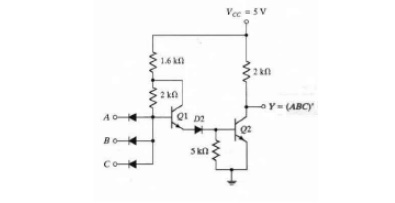The basic circuit in the OTL digital logic family is the NAND gate shown. Each input is associated with one diode. The diodes and the 5·kO resistor from exor gate. The transistor serves as a current amplifier while inverting the digital signal. The two voltage levels are 0.2 V for the low level and between 4 and 5 V for the high level. The analysis of the DTL gate should conform to the conditions listed in for the NAND gate. If any input of the gale is low at 0.2 V. the corresponding input diode conducts current through Vee and the 5-kfl resistor into the input node . The voltage at point P is equal 10 the input voltage of 0.2 V plus a diode drop of 0.7 V, for a total of 0.9 V. In order for the transister to start conducting, the voltage at point P must overcome (i.e., be at least as high as) a I·VBE drop in QJ plus two diode drops across DI and D2, or 3 X 0.6 = 1.8 V. Since the voltage at P is maintained at 0.9 V by the input conducting diode. the transistor is cut off with no drop across the 2-kO resistor. and the output voltage is high at 5 V. If all input s of the gate are high , the transistor is driven into the saturation region . The voltage at P now is equal to VBE plus the two dio de drops across DI and D2, or0.7 X 3 = 2.1 V. Since all inputs are high at 5 V and since Vp = 2.1 V, the input diodes are reverse biased and off. The base current is equal to the difference of the current s flowing in the IWO 5·k n resistors and is sufficient to drive the transistor into saturation. With the transistor saturated, the output drops to Va = 0.2 V, which is the low level for the gate . The power dissipation of a DIL gate is about 12 mW and the propagation delay averages 30 ns. The noise margin is about I V and a fan-out as high as 8 is possible . The fan-out of the DIL gale is limited by the maximum current that can flow in the collector of the saturated transistor. The fan-out of a DTL gate may be increased by replacing one of the diodes in the base circuit with a transistor, as shown in Fig. 10.10. Transistor Ql is maintained in the active region when output transistor Q2 is saturated. As a consequence, the modified circuit can supply a larger amount of base current to the output transistor, which can now draw a larger amount of collector current before it goes out of saturation . Part of the collector current comes from the conducting diode s in the loading gates when Q2 is saturated. Thus, an increase in the allow able saturated current in the collector allows more loads to be connected to the output, increasing the fan-out capability of the gate


